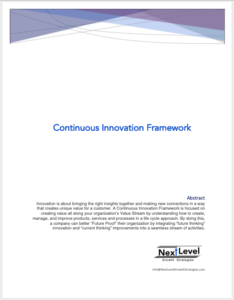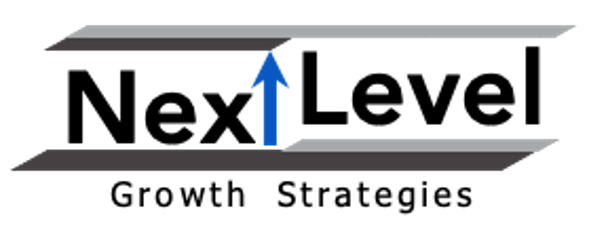Continuous Innovation Framework
Innovation is about bringing the right insights together and making new connections in a way that creates unique value to a customer. A Continuous Innovation Framework is focused on creating value all along your organization’s Value Stream by understanding how to create, manage, and improve products, services and processes in a life cycle approach. By doing this, a company can better “Future Proof” their organization by integrating “future thinking” innovation and “current thinking” improvements into a seamless stream of activities.
The Continuous Innovation Framework is comprised of five pillars divided into three major themes.
- The first theme focuses on creating an innovation framework for the organization or business unit
- The second theme is the Innovation process called the i3 Innovation Process. The i3 Innovation Process contains all the steps necessary to identify, develop, and bring a new product or capability to market.
- The third theme centers on continually improving existing products, services, and processes using the C5 process based on Lean Six Sigma principles.
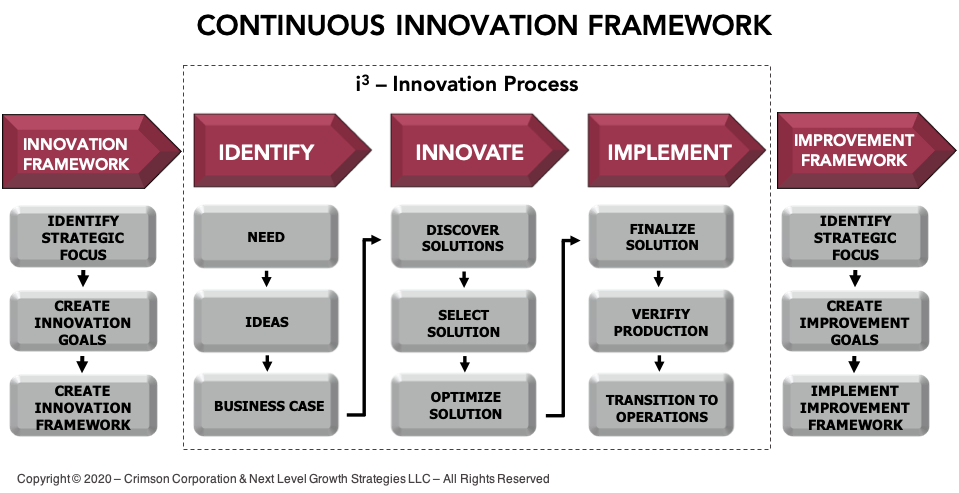
Innovation Framework
It is vital that the Innovation goals and structure are 100% aligned with your organization’s Mission, Vision, Purpose, and Identity – and that these are well understood and fully agreed upon throughout the entire enterprise. Without this alignment, Innovation generally doesn’t happen consistently. Creating an innovation framework upfront will help ensure new solutions are connected to your organization’s goals.
Questions for success:
- Do we understand our core competencies as an organization and leadership team around product / service / process innovation?
- Have we defined acceptance criteria for selecting new innovation initiatives?
- Have we created a portfolio strategy for new innovation initiatives focused on expanding, optimizing and / or establishing new product/service/process solutions?
- Have we started an innovation pipeline process that includes all stakeholders?
- Can we clearly articulate our organization’s innovation process?
Steps for Success:
Step 1 – Strategic Focus
Your organization’s culture, business model, and current performance will often determine the amount, and types of risks you are willing to undertake, and what types of innovations are appropriate. Keep in mind that most organizations focus the majority of their efforts on maintaining and refining existing products, services, and processes and allocating only a small percent of their resources towards disruptive forward-looking initiatives. Your innovation strategy must support and amplify your organization’s goals and objectives, and you must understand what’s right for your business, and ultimately your customers.
Step 2 – Innovation Goals
Once you’ve determined the “right” mix of innovation initiatives, you now have to understand your boundaries and establish what “success” looks like. Do you want to focus on new disruptive and transformational innovation initiatives primarily, or do you want to “stay closer to home?” It is also equally important to set revenue as well as other performance goals for each innovation effort. Keep in mind that each initiative’s goals will depend upon the type of initiative you are undertaking: Optimizing, Expanding, and Establishing new products, services, processes, and capabilities. Leveraging the Strategic Growth Framework (illustrated below) is useful for thinking through your organization’s portfolio of innovation options.
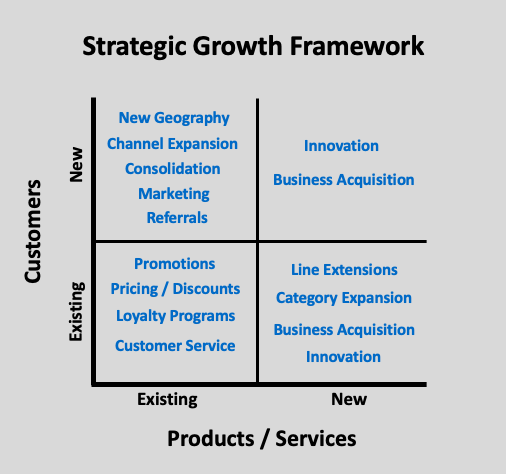
Step 3 – Create Innovation Framework
Every organization must realize that growth doesn’t just happen on its own. It is a mindset and competency that you must develop in ALL of your organization’s employees. Adopting and adapting a framework that fits your organization’s culture as well as supports your overarching mission, vision and goals is critical to success.
IDENTIFY
How well does your organization understand the wants and needs of your core customers? Deeply understanding your customers and the role your organization plays in their lives is a foundational requirement for every successful innovation initiative. Understanding most of their needs is not sufficient. You MUST identify all of their met and unmet needs, and determine which ones fit your organization’s Innovation Strategy.
Questions for Success:
- Who is our Core Customer? And, who is our Target Customer? Are they the same?
- What value do our products and / or services provide to our customers?
- Using the “Jobs to Be Done” [HBR Business Publishing Link] framework, have we identified what Job(s) our offerings are hired for?
- What makes our organization unique from our customer’s point of view?
- Have we identified consumers and customers whose needs are under, over, or appropriately met by our offerings?
- Have we identified ALL of our target customer’s unmet and underserved needs?
- How big is the potential opportunity to address the identified, unmet, or underserved needs uniquely?
Steps for Success:
1) Identify Need
Through observations, customer interactions, and research, you must understand:
- The Job your customer is trying to get done.
- What solutions are your customers currently utilizing to get their Job done?
- Are these solutions adequate?
- Are their needs not being fully met?
- Identify all of your customer’s unmet and underserved needs and determine how well the market is currently satisfying those needs today.
2) Identify (and screen) Ideas
Once you have identified all of the unmet and underserved needs, you need to come up with as many ideas as possible for satisfying them. There are several highly useful creative thinking tools and techniques you can utilize here. The next step is to filter or screen your ideas by grouping them into themes and determining which ones make the most sense for your organization to pursue. The NABR model is a useful technique to winnow down your list
- Needs – What is the essential consumer or market need that we intend to address, why is it important? And how important is it?
- Approach – What is our unique system (idea) for delivering against this unmet or underserved need?
- Benefits – What are the benefits (to the consumer and to the organization) net of costs?
- Risks – What are the risks to the organization of pursuing (or not pursuing) this opportunity? Is there a risk of someone else doing it if we don’t, and will that cost us market share? How defensible is our solution – can someone else quickly and easily copy it? Do we have the ability to do it better and more efficiently than anyone else?
3) Create Business Case
In this step, you estimate the market potential for uniquely solving (via innovation) your customers unmet and/or underserved needs that made it through your screening process. You next need to create a more formal business case, assemble your cross-functional innovation team, and create your Innovation Project Charter.
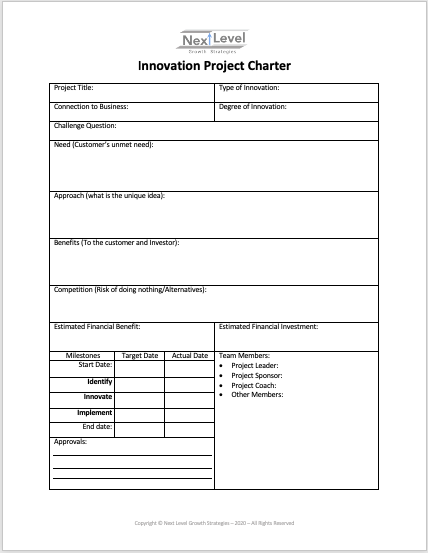
Download your free copy of the Next Level Growth Strategies
Continuous Innovation Project Charter Template
INNOVATE
Your Innovation Team is now ready to start coming up with potential solutions that solve the customer’s unmet or underserved needs. Utilizing your narrowed down list coming out of the IDENTIFY phase, you can now select the “best” option(s) to pursue. The INNOVATE phase is Agile and very iterative, focusing on learning quickly and “failing fast”.
Questions for success:
- Have we included all of the right people in our idea and solution discovery processes?
- Are we looking at the big picture (our entire Value Stream) when designing potential solutions?
- What can we begin to release and pressure-test with actual customers as quickly as possible?
- Do we have an understood and agreed-upon process for evaluating and approving and/or killing Minimum Viable Product (MVP) concepts?
- Are our best (most valuable) customers early adopters? If so, how are our solutions designed to satisfy their wants and needs?
- Do we include them in the MVP assessment process?
Steps for Success:
1) Discover Solutions
Use your creative skills and creative thinking techniques to develop concepts for satisfying your customers’ need(s). A solution for this need may already exist, but it might not entirely be getting the job done. Is there something already in the market that you can improve?
2) Select Solution
By leveraging a “Lean” prototyping and testing cycle, quickly narrow in on the winning (or champion) product service / process innovation solution. Be certain that your core customer believes this solution uniquely solves their unmet need, and that it will create new value for them and your enterprise.
3) Optimize Solution
Once you’ve identified your champion solution, start refining it to ensure it fully satisfies your customer’s needs. You will also expand your focus by looking at upstream and downstream implications across your entire Value Stream.
IMPLEMENT
The best idea turned into the best solution will still fail if it isn’t implemented correctly. An Extreme focus MUST be placed on the hand over from the innovation team to the “Production” and “Operation” teams. It is also vital to ensure that manufacturing and product quality can be sustained over time and at scale.
Questions for success:
- Have we defined and documented all core processes? Are there steps that we need to own? Are there steps we can / should outsource?
- Have we created solutions with the end in mind to avoid creating things that can’t be adequately supported?
- Do we have appropriate monitoring and feedback processes in place throughout all steps in the Implement phase?
- Do we have execution and response plans for all possible scenarios and situations spanning the entire Implement phase?
- Are all of our processes and decisions adequately organized around our customers? Does our customer support/service model need to change?
Steps for Success:
1) Finalize Solution
A champion solution has been confirmed by initial testing, but now you need to conduct a pilot on a larger scale. This step is where it is critical to test for failure points and finalize all safety protocols. The final review also needs to include legal, risk, and regulatory impacts.
2) Validate/Verify Production Solution
This is where you Verify that the product / service / process is maintainable. Can the organization repeatedly be successful making / distributing / support the product or executing the service or process? It is also important to focus on how (and how often) future changes to the solution will be made by the organization.
3) Transition to Operations
As the solution is moved into full-scale production, it is crucial to make sure processes are in place to measure and resolve any issues or manage requests for new features that could arise. The transition step is also the time to ensure that day-to-day operating processes and structures are in place and organized to provide effective and efficient daily operations.
IMPROVEMENT FRAMEWORK
The only thing you can count on in business is change. Products, services, and processes must be constantly monitored to ensure they continue to meet your customers’ needs. Many organizations struggle to produce sustained top-line and bottom line growth because they get caught up in the pursuit of operational efficiency at the expense of business effectiveness and brand growth.
Questions for success:
- Are we measuring value through the customer’s eyes?
- What are our customer’s expectations for issue resolution and incorporating their feedback? How do we monitor and ensure customer feedback is leveraged throughout the entire value chain?
- How do we define “defect?” What is our process for detecting and resolving defects?
- Have we created a Continuous Improvement (CI) pipeline process that includes all stakeholders?
- Can we clearly articulate our Continuous Improvement process for improving our current products and services?
Steps for Success:
1) Identify Strategic Focus
Ensuring that Continuous Improvement is engrained in everyone’s day-to-day activities is table stakes for today’s organizations. Defining how CI fits our corporate strategy ensures that the proper focus is placed on improving products, services, and processes and not just cutting costs.
2) Create Continuous Improvement Goals
Creating actionable CI goals is important to ensure the right balance placed in Innovation and Improvements. The goals must connect to the organization’s overarching strategic objectives and goals for them to be embraced as a part of the company’s priorities, culture, and competencies.
3) Create / Implement Continuous Improvement Framework
Many organizations have a process for Continuous Improvement already in place. Unfortunately however, these processes are often informal and deployed at a department-level, creating pockets or silos of improvements. By developing and implementing a consistent enterprise-wide approach like Lean Six Sigma, an organization can create a sustainable process for improvement that benefits customers, employees, and stakeholders.
Nearly every organization has a stated objective of growth; they want to be bigger and want to make more money. And Innovation is the mechanism that fuels growth! However, without defined innovation goals, objectives, and processes, innovation is often treated like a side project rather than a needed function or core competency like Accounting, Finance, Marketing, Operations, etc.
An Innovation Strategy is the thing (or plan) that helps your organization be innovative – continually. It is the aligning mechanism that can assist your organization in achieving its overall growth strategy and goals. And the Continuous Innovation Process is the roadmap that enables systematic and sustainable innovation; creating a pipeline of new ideas that becomes the flywheel of growth.
By adopting the Continuous Innovation Framework, built on a foundation of Agile and Lean principles and supported by a structured performance feedback loop, you will ensure continual business growth opportunities, furthering your Brand’s Mission/Vision, and secure customer loyalty.
To download a FREE copy of the Continuous Innovation Framework white paper (PDF), please complete this form.
